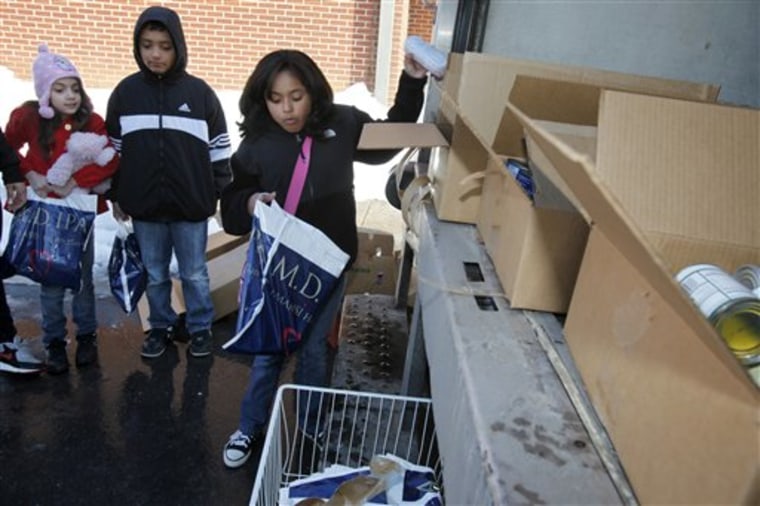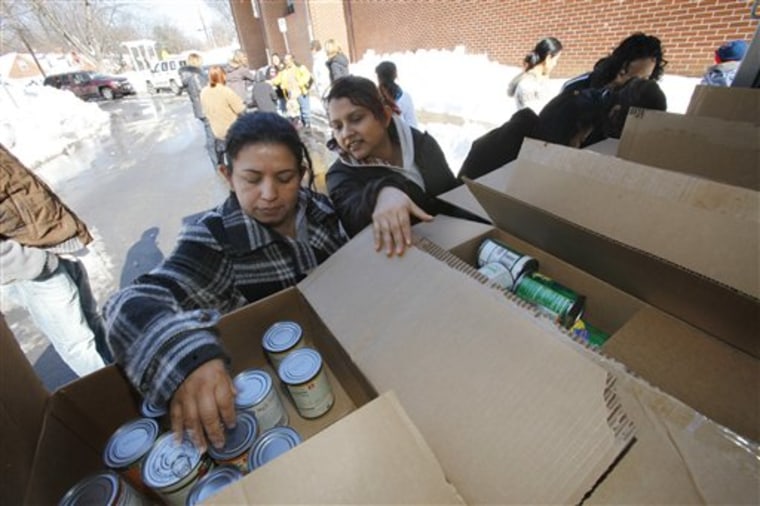As back-to-back snowstorms shuttered schools for the week across the mid-Atlantic states, parents fretted about lost learning time, administrators scheduled makeup days and teachers posted assignments online. But Marla Caplon worried about a more fundamental problem: How would students eat?
The two snowstorms that pummeled the region, leaving more than 3 feet of snow in some areas, deprived tens of thousands of children from Virginia to Pennsylvania of the free or reduced-price school lunch that may be their only nutritious meal of the day. The nonprofits that try to meet the need when school is not in session also closed their doors for much of the week, leaving many families looking at bare cupboards. And many parents working hourly jobs were unable to earn any money during the week, as the snow forced businesses to close.
Caplon is a food services supervisor for Montgomery County Public Schools, where about 43,000 children are eligible for free or reduced-price lunches. Some also get breakfast, dinner and bags of staple foods to take home for the weekend. The snow days meant children would get none of that until Tuesday, because schools are closed Monday for Presidents Day.
"We've been bothered by this all week," Caplon said.
So Caplon arranged for Manna Food Center, a local food bank whose board she chairs, to bring boxes of food Friday to two still-closed elementary schools. Officials used the school district's automated phone system to notify parents of the distribution.
Short on food
At Rolling Terrace Elementary School, a stream of people walked up to a Manna truck in the school's bus bay Friday. They filled plastic shopping bags with cans of soup, vegetables and beans, ground beef and Rice Krispy Treats.
"Everybody's at home, and everybody's eating," said Jacquelyn Garcia, 39, who came to pick up food for her family of five. "I have nothing left in my house."
Manna's effort brought out smiles and expressions of gratitude. But the approximately 200 families who came to pick up provisions represent just a fraction of the need in Montgomery County, let alone the entire snow-battered region.

In Philadelphia, where public schools opened only one day this week, nearly 86,000 free lunches are served every day. In Baltimore, where schools were closed all week, a district spokeswoman estimated about 50,000 students take advantage of free and reduced-priced meals. The District of Columbia, which has had no school the entire week, has 32,000 public school students eligible for the program. Schools in Fairfax County, Va., which have about the same number of eligible students, have been closed since Feb. 5, when the first of the two storms rolled in.
Otto Tambito, a Fairfax County father of two, said his family burned through much of its savings during the week off from school and work. Tambito works as a window cleaner and an electrician, but was unable to travel to jobs. His wife, who cleans houses for a living, was in the same boat.
"We hope that thing melts down and we start again," he said.
Maritza Hernandez, a 32-year-old mother who came to pick up food Friday, said her usual baby-sitting income dried up during the snow days, and her husband had no work either. The couple and their 5-year-old son survived all week on beans, tortillas and the occasional egg, she said.
"We were sad that we didn't have enough to go shopping," she said.
Shortfall in emergency help
Nationwide, about 19.4 million students received free or reduced-price lunches on a typical school day last year, according to the U.S. Department of Agriculture.
Student hunger during breaks in the school year is not a new a concern. The Agriculture Department runs a summer food program to help fill the gap, though it doesn't reach everybody.
"The demand for emergency food for families with children in the summertime goes up," said Crystal FitzSimons, director of school programs at the Washington-based Food Research and Action Center, a nonprofit that fights hunger in the U.S. "Parents are more likely to skip meals, so their kids can eat."
The storm-related school closures were arguably more problematic because the emergency assistance typically provided by food pantries was also unavailable.
In Baltimore, the Bea Gaddy Family Centers opened Monday, but had to close Tuesday ahead of the second storm. The organization provides food, shelter and clothing to those in need.
"We tried to give out what we had to hold people over," said executive director Cynthia Brooks. "A lot of the people couldn't get up to the pantry because of the snow from the last storm."
